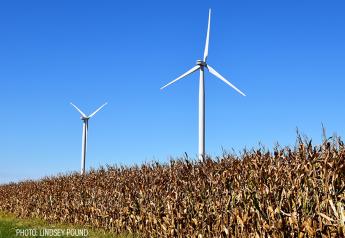WASDE: Corn, soybean price forecasts lowered slightly

According to the USDA's latest World Agricultural Supply and Demand Estimates report, season-average farm prices for both corn and soybeans are expected to be lower than forecast in December:
Coarse Grains
U.S. feed grain supplies for 2015/16 are lowered as small increases in corn and sorghum imports and sorghum production are more than offset by a reduction in corn production. Harvested area for corn is raised slightly, but the national average yield is estimated 0.9 bushel per acre lower than the previous forecast at 168.4 bushels per acre. Corn production for 2015/16 is estimated 53 million bushels lower, but remains the third largest crop on record at 13.6 billion. Sorghum production is estimated 3 million bushels higher as an increase in harvested area more than offsets a reduction in yield.
Total projected corn use for 2015/16 is reduced slightly with lower projected food, seed, and industrial use and exports. Feed and residual use is unchanged as September-November disappearance, as indicated by the December 1 stocks, was largely in line with expectations.
Corn used to produce ethanol is unchanged, but projected use for sweeteners is lowered 10 million bushels. Exports are lowered 50 million bushels based on the slow pace of sales and shipments to date and continued strong competition from South American suppliers.
Corn ending stocks are projected 17 million bushels higher at 1.8 billion bushels, stocks remain the highest since 2005/06. The projected range for the 2015/16 season-average corn farm price is lowered 5 cents on each end to $3.30 to $3.90 per bushel reflecting weakness in export demand and recent declines in cash and futures prices.
The sorghum farm price is lowered 20 cents at the midpoint to a range of $3.05 to $3.55 per bushel reflecting the weakening relationship to cash corn prices in interior markets.
Oilseeds
U.S. oilseed production for 2015/16 is estimated at 116.2 million tons, down 1.5 million from last month. Smaller crops for soybeans, canola, and cottonseed are only partly offset by increases for sunflower seed and peanuts. Soybean production is estimated at 3,930 million bushels, down 51 million on lower harvested area and yields.
Harvested area is estimated at 81.8 million acres, down 0.6 million from the previous forecast. Yield is estimated at 48.0 bushels per acre, down 0.3 bushels, but still a record. With lower supplies, exports are reduced 25 million bushels to 1,690 million.
Ending stocks are projected at 440 million bushels, down 25 million from last month. Although soybean crush is unchanged, soybean meal production is reduced on a lower extraction rate. Soybean meal exports are reduced on a slowing pace of sales and increased competition from Argentina. Soybean oil balance sheet changes include increased production on a higher extraction rate, increased imports, and increased domestic use.
The 2015/16 U.S. season-average farm price forecast for soybeans is projected at $8.05 to $9.55 per bushel, down 10 cents at the midpoint based on prices reported to date. Soybean meal is forecast at $270 to $310 per short ton, down 20 dollars on both ends.
The soybean oil forecast is unchanged at 28.5 to 31.5 cents per pound.
Read the full report from the USDA here.







